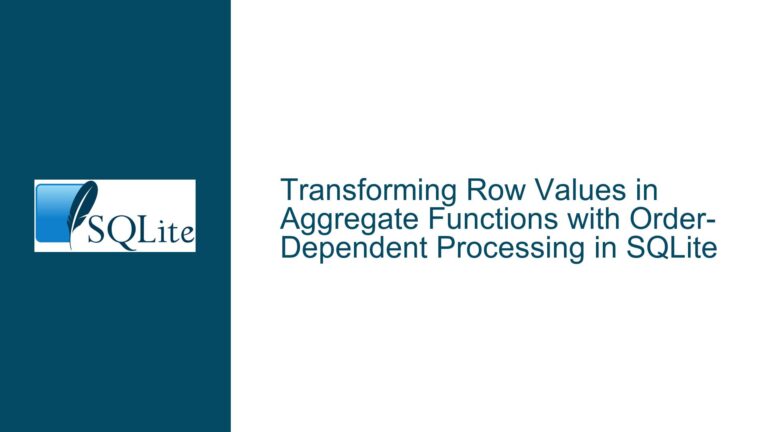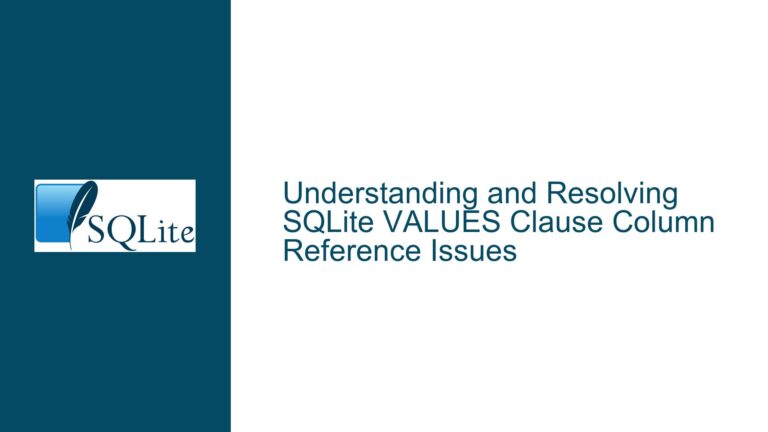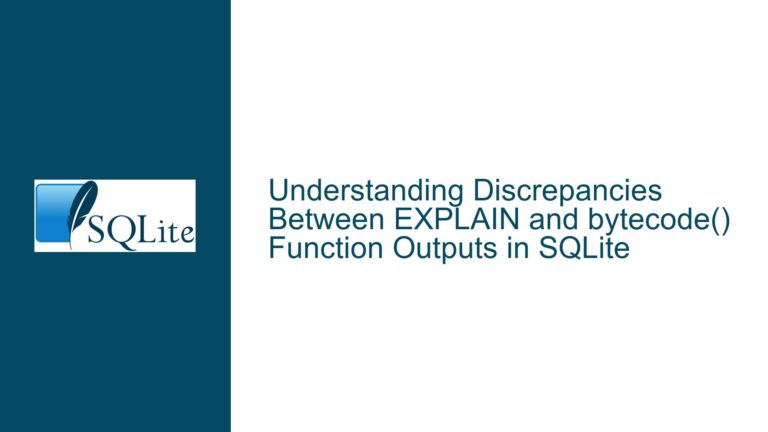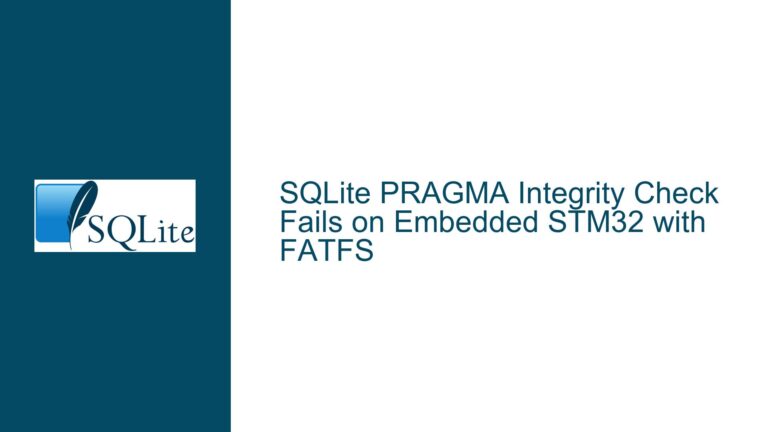SQLite Parser Stack Overflow Due to Deeply Nested Subqueries
Deeply Nested Subqueries Causing Parser Stack Overflow
The core issue in this scenario revolves around a SQLite query that attempts to parse and break down file paths into their constituent directory levels and file names. The query is structured as a deeply nested set of subqueries, each level of which is responsible for extracting a single directory level from the file path. This approach, while logically sound, leads to a "parser stack overflow" error in SQLite. The error occurs because SQLite’s parser has a fixed stack size, and the deeply nested subqueries exceed this limit.
The parser stack overflow error is a direct consequence of the query’s design. SQLite’s parser is optimized for typical SQL queries, which rarely require such deep nesting. When the nesting depth exceeds the parser’s stack size, SQLite throws the "parser stack overflow" error. This is a protective mechanism to prevent the parser from consuming excessive memory or crashing due to stack exhaustion.
The query in question attempts to parse a file path into up to nine directory levels and a file name. Each directory level is extracted using a subquery that relies on the substr and instr functions to split the path at each backslash (\). The nesting depth of the query is directly proportional to the number of directory levels being parsed. For example, parsing a path with nine directory levels requires nine levels of nested subqueries. This design, while functional for shallow paths, becomes problematic for deeper paths or when the nesting depth exceeds SQLite’s parser stack limit.
The parser stack overflow error is not unique to this specific query. It can occur in any SQLite query that involves deeply nested subqueries, complex expressions, or recursive common table expressions (CTEs) that exceed the parser’s stack size. The error is a manifestation of SQLite’s design philosophy, which prioritizes simplicity and efficiency over accommodating extremely complex queries.
Fixed Parser Stack Size and Runtime Limit Adjustments
The parser stack overflow error is exacerbated by the fact that SQLite’s parser stack size is fixed at compile time. While SQLite provides a .limit command in the CLI tool to adjust various runtime limits, the parser stack size is not one of them. The .limit expr_depth command, which adjusts the maximum expression depth, does not affect the parser stack size. This is a critical distinction because the parser stack size governs the nesting depth of subqueries, while the expression depth governs the complexity of individual expressions within a query.
In the provided discussion, the user attempts to adjust the expression depth limit using the .limit expr_depth command. However, this adjustment has no effect on the parser stack overflow error because the issue is not related to expression depth but rather to the nesting depth of subqueries. The parser stack size is determined at compile time and cannot be adjusted at runtime. This limitation is intentional, as increasing the parser stack size would negatively impact the performance of the parser for all queries, not just those that require deep nesting.
The user also attempts to set the expression depth limit to 0, which theoretically allows the expression depth to grow without bound. However, this setting does not resolve the parser stack overflow error because the parser stack size remains fixed. The error persists because the query’s nesting depth exceeds the parser’s stack size, regardless of the expression depth limit.
The fixed parser stack size is a design choice that reflects SQLite’s emphasis on efficiency and simplicity. By limiting the parser stack size, SQLite ensures that the parser remains fast and memory-efficient for the vast majority of queries. However, this design choice also means that SQLite is not well-suited for queries that require extremely deep nesting or complex parsing logic.
Optimizing Path Parsing with Recursive CTEs and Pivot Logic
The solution to the parser stack overflow error lies in restructuring the query to avoid deeply nested subqueries. One effective approach is to use a recursive common table expression (CTE) to parse the file path iteratively, rather than relying on nested subqueries. A recursive CTE is well-suited for this task because it allows the query to process the file path one directory level at a time, without exceeding the parser’s stack size.
The recursive CTE approach involves defining a base case that extracts the first directory level from the file path and a recursive case that processes the remaining path. The recursive case continues to extract directory levels until the entire path has been parsed. This approach eliminates the need for deeply nested subqueries and avoids the parser stack overflow error.
In addition to using a recursive CTE, the query can be further optimized by incorporating pivot logic to transform the parsed directory levels into columns. The pivot logic involves using conditional aggregation to assign each directory level to its corresponding column. This approach is more efficient than the original query because it processes the entire path in a single pass, rather than requiring a separate subquery for each directory level.
The following example demonstrates how to parse a file path using a recursive CTE and pivot logic:
WITH RECURSIVE DirLevels AS (
SELECT rowid,
0 AS Level,
substr(PathFileName, 1, instr(PathFileName || '\', '\') - 1) AS DirName,
substr(PathFileName, instr(PathFileName, '\') + 1) AS Tail
FROM T1
UNION ALL
SELECT rowid,
Level + 1,
substr(Tail, 1, instr(Tail || '\', '\') - 1) AS DirName,
CASE WHEN instr(Tail, '\') THEN substr(Tail, instr(Tail, '\') + 1) ELSE '' END
FROM DirLevels
WHERE Tail != ''
)
SELECT rowid,
MAX(CASE WHEN Level = 0 THEN DirName END) AS DirLev0,
MAX(CASE WHEN Level = 1 THEN DirName END) AS DirLev1,
MAX(CASE WHEN Level = 2 THEN DirName END) AS DirLev2,
MAX(CASE WHEN Level = 3 THEN DirName END) AS DirLev3,
MAX(CASE WHEN Level = 4 THEN DirName END) AS DirLev4,
MAX(CASE WHEN Level = 5 THEN DirName END) AS DirLev5,
MAX(CASE WHEN Level = 6 THEN DirName END) AS DirLev6,
MAX(CASE WHEN Level = 7 THEN DirName END) AS DirLev7,
MAX(CASE WHEN Level = 8 THEN DirName END) AS DirLev8,
MAX(CASE WHEN Level > 8 THEN DirName END) AS FilNam
FROM DirLevels
GROUP BY rowid;
This query uses a recursive CTE (DirLevels) to parse the file path into directory levels. The base case extracts the first directory level, and the recursive case processes the remaining path. The SELECT statement uses conditional aggregation to pivot the parsed directory levels into columns. The MAX function is used to assign each directory level to its corresponding column, and the CASE expression ensures that the file name is placed in the FilNam column.
The recursive CTE approach is more efficient and scalable than the original query because it avoids deeply nested subqueries and processes the entire path in a single pass. This approach also eliminates the risk of parser stack overflow, as the recursive CTE does not rely on deep nesting.
In conclusion, the parser stack overflow error in SQLite can be resolved by restructuring the query to avoid deeply nested subqueries. The recursive CTE approach, combined with pivot logic, provides an efficient and scalable solution for parsing file paths into directory levels and file names. This approach leverages SQLite’s strengths while avoiding its limitations, ensuring that the query remains performant and reliable.






